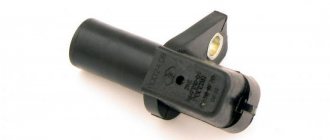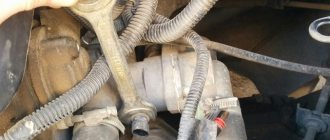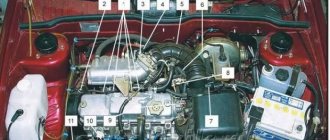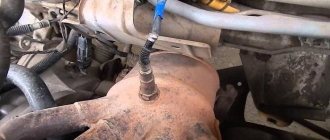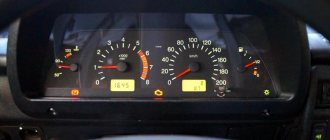This article describes all injector sensors on VAZ family cars. The article is generalized, since all sensors installed on cars of the Volzhsky Automobile Plant are identical to each other and even interchangeable.
After studying the article, you can easily determine the location of the sensor, understand its symptoms of malfunction, and also learn about its purpose. This material only talks about sensors on fuel-injected cars, since there are negligible numbers of engine control sensors in carburetor versions, and besides, there are fewer and fewer carburetor cars.
The engine control unit
All injection Ladas have a special unit that reads and processes readings from all sensors in the car system. This block is a small part made of plastic and metal, inside of which there is a microcircuit with many radio components. It is this block that sends signals to the fuel pump, injectors and ignition module, and also forms the ignition timing, controls the operation of fans, etc. This is a kind of car head unit.
Location
In all Lada models it is located in the cabin, in classic Lada models it is located under the glove box, in front-wheel drive Ladas the ECU is located under the center console. The location of the ECU can be called a problematic place in Lada Granta and Kalina cars, since the ECU is located under the heater radiator, which quite often exposes it to getting wet with antifreeze and disabling it. Many owners of these cars move the ECU under the glove box.
Symptoms of a problem
The unit does not have a malfunction as such; its failure may be associated with the failure of any of the sensors. For example, if one of the cylinders fails, the problem may lie not in the ignition module or coil, but in the key located in the ECU. Often a radio component that burns out inside the unit can affect the operation of any of the sensors.
Where are the sensors located?
All modern Lada cars (Granta, Kalina, Priora, Vesta, Largus, Niva or Lada XRAY) are equipped with domestic VAZ engines. The location of the sensors on these motors is the same:
Elements of the electronic engine control system of the VAZ 11186/11189: 1* – controller; 2* – crankshaft position sensor; 3* – control oxygen concentration sensor; 4* – diagnostic block; 5* – diagnostic oxygen concentration sensor; 6 – throttle control unit; 7* – vehicle speed sensor; 8* – adsorber purge valve; 9* – gas pedal module; 10* – brake signal switch; 11* – clutch pedal position sensor; 12 – battery; 13 – mass air flow sensor; 14 – coolant temperature sensor; 15 – ignition coil; 16 – knock sensor; 17 – spark plugs; 18* – nozzles. *The item is not visible in the photo.
Location of ECM elements in the vehicle interior (for clarity, without dashboard): 1 – clutch pedal position sensor; 2 – brake signal switch; 3 – gas pedal module; 4 – controller.
Crankshaft position sensor
Installed on all Lada cars with an injection engine, it serves to determine the top dead center of the piston. Based on its readings, the engine control unit reads readings about the position of the pistons in the engine. After receiving the data, the ECU sends signals to the ignition module and injectors to supply a spark and fuel at the right time and into the right combustion chamber of a certain cylinder.
The sensor operates on the principle of electromagnetic induction. It itself is made of plastic, inside of which there is a magnet with a winding. A drive disk (crankshaft pulley) rotates next to the sensor, from which the sensor reads readings. There is a special slot on the pulley, the so-called “caries”, this slot makes it clear to the sensor what position the pistons and crankshaft are currently in.
Location
The sensor is located on all Frets in one place, near the generator drive pulley, this part is attached via a bolt. On the oil pump body there is a special cast bracket in the form of an ear; the sensor is inserted into it and secured with an M6 bolt.
Symptoms of a problem
If the crankshaft sensor fails, the car will not start due to a missing spark and injectors not working. Loss of communication with the sensor blocks the operation of the ignition module and injectors, causing fuel to enter the oil, etc. Also, if the sensor breaks down, the engine may start to stall, but this only happens when the sensor has not yet completely failed.
Location of sensors on VAZ 2110 injector (8 valves)
The fuel-injected 8-valve VAZ 2110 has a wide variety of sensors. Each of them has its own important function, the termination of which can lead to certain consequences.
Mass air flow sensor on VAZ 2110
It is obvious that the injector has long surpassed the carburetor in all respects. If only for the reason that in injectors the electronics are responsible for supplying fuel and air-fuel mixture to the cylinders. Efficiency, economy and a number of other advantages have literally displaced the carburetor from its once leading position.
The presence of a large number of electronics provides an abundant number of sensors. We will talk about some of them today:
- Air regulator sensor;
- Fan switch sensor;
- Crankshaft sensor;
- Coolant temperature sensor;
- Speed sensor;
- Phase sensor.
Now let's look at them in more detail.
Knock sensor
With the advent of injection engines in Lada, regulation of the ignition timing angle (IAP) went into oblivion. This task began to be performed automatically, but as is known, the quality of the fuel also affects ignition, therefore, in order to avoid large detonations in the engine when using low-quality fuel, a knock sensor was used, which detects the slightest detonations in the engine and transmits the readings to the ECU, which in turn, changes the OZ to ensure normal engine operation.
The DD is a round part with a hole inside for attaching it to the engine body. It works similar to a piezoelectric element, that is, when struck, it produces a small electrical voltage. When detonations occur in the engine, the sensor detects them and transmits voltage pulses to the engine control unit to adjust the SOP.
Location
On all Lada models, regardless of the drive type, this part is located on the engine block and secured with a bolt. There are also sensors that themselves have a thread and are screwed into the body of the cylinder block. More precise location of the sensor in the center between cylinders 2 and 3.
Symptoms of a problem
If the sensor breaks down, the engine begins to operate in emergency mode, that is, the ECU can no longer adjust the OZ, and if you refuel with low-quality fuel, then an unpleasant knocking sound appears on the car, and its operation becomes uneven and rough, vibrations appear at idle and consumption increases fuel.
What is the knock sensor on the VAZ 2107 responsible for?
Detonation is an extremely undesirable phenomenon. During normal operation of a vehicle engine, the flame front moves at a maximum speed of up to 30 m/s, and when the fuel detonates, the speed sometimes reaches 2000 m/s.
As a result of the impact of such force on the pistons, as well as the cylinder head (cylinder head), there is a high probability of serious damage after the car has driven 6,000 km.
Due to detonation, first of all, the gas distribution mechanism of the car (timing mechanism), as well as the piston group, suffers. To prevent this from happening, a knock sensor is used. The fuel mixture should begin to ignite before the piston reaches the top position. The ignition process must end when the piston returns.
During detonation, premature combustion begins before the moment when a spark occurs between the electrodes of the car spark plug. There is a strong impact on the piston, as a result of which the engine loses power, while fuel consumption increases significantly.
In the case of forced engines, detonation occurs at high speeds and can damage the engine in just a few seconds.
Detonation occurs for several reasons. Of them:
- the octane number of the fuel does not correspond to the recommended one;
- failure to comply with operating conditions;
- failure of the knock sensor.
Detonation sometimes occurs even when the ignition is turned off. The engine continues to run even though the spark supply has stopped. The reason for this phenomenon is the strong heating of the parts of the CPG, or, more simply, “glow ignition”.
Read, it may come in handy: How the exhaust system of the VAZ 2101-2107 works and works, repairs and modifications
A feature of an engine with an injector is the ability to change the advance angle using a distributor. All modern cars are equipped with injection engines.
Coolant temperature sensor
In carburetor Lada models, the coolant temperature sensor was used to turn on the cooling fan, but in the injection version of cars, this DTOZ began to perform several functions. For example, the sensor in modern modes is involved in adjusting the fuel mixture, turning on the fan, and also displays information about the coolant temperature on the dashboard. The fuel mixture is adjusted based on temperature, that is, when the engine is cold, it needs a rich mixture, but when the engine is hot, the mixture needs to be leaner.
Location
The sensor can be found under the car air filter housing; it is located in the thermostat housing and is connected to a connector with two wires. The sensor is screwed in through a threaded connection, and a special O-ring is located between the DTOZH and the thermostat body.
Symptoms of a problem
When the sensor fails, the car experiences increased fuel consumption, as well as a lack of warm-up speed, the engine may begin to have trouble starting. All of these problems indicate a problem with the temperature sensor.
How to disable or remove the adsorber on a car and do you need to reflash the ECU?
You need to understand that when the adsorber is removed, the solenoid valve is turned off, which is directly connected to the controller and controlled by the latter.
What is the disadvantage of such a shutdown?
This will lead to error p0443, which we already mentioned above. The tubes are also muffled, in particular the one that goes to the intake manifold. The fact is that through the tube that goes to the intake manifold, air is constantly sucked in, even in idle mode, the so-called small purging of the adsorber occurs. At high speeds from 1500 – 2000 and above there is a lot of purging.
In the ECU firmware, constant air leaks and the flow of fuel vapor are taken into account when forming the air-fuel mixture, despite the fact that all this goes past the mass air flow sensor, the causes of the malfunction of which can be found out by clicking on the link.
If you plug the pipe, which many people do, a certain amount of air will not flow into the intake manifold bypassing the ECU, but the latter still takes them into account.
That is, the controller takes into account one volume of air, but another (smaller) one actually enters. As a result, the amount of fuel is generated by the ECU based on more air than is supplied. This leads to an over-enrichment of the air-fuel mixture.
As a result, the engine does not work correctly, because the mixture is constantly over-enriched where it is and is not needed, and fuel consumption increases.
It is also worth talking about the transient mode of operation of the engine, which can manifest itself when approaching an intersection, a traffic light, lying to a policeman, at the moment when the gas is released.
At this moment, a failure may occur - a decrease in speed below idle. The engine seems to choke, it doesn’t have enough air, the reason is an over-enriched mixture. After a few seconds, the situation is resolved electronically.
Therefore, it would be correct to disable the adsorber in the following ways:
- After removing the device, install a nozzle with a diameter of 1 mm into the tube that goes directly past the mass air flow sensor. This will, at least partially, solve the problem, since only air without gasoline vapors will be supplied in doses.
- The ECU is being reflashed (difficult). If it is impossible to remove the Check error, you may need engine chip tuning, which is expensive.
- Dismantling the entire system except the solenoid valve, which operates idle.
- By installing a resistor (valve emulation) in the electrical circuit at 200 - 250 Ohms and 2 watts. To do this, bend the legs of the resistor and insert them into the valve chip. We secure everything with electrical tape. But this doesn't always help.
Speed sensor
Older Lada models, such as the VAZ 2108 and Classic, used a mechanical speedometer drive, but with the advent of the injector, more electronics appeared in cars and the mechanical speedometer drive went into oblivion. Currently, an electronic speedometer is used in all Ladas; it is a part that works on the principle of electromagnetic induction, which reads readings from the crankshaft gear and transmits them to the engine control unit. The main task of the speed sensor is to calculate the speed, but in models with electric power steering, the speed sensor affects the operation of the power steering.
Location
The speed sensor is located predictably on the gearbox housing, near the gearbox oil level dipstick. The sensor is attached through a bolted connection, and the tightness is ensured by a special oil-resistant sealing ring.
Symptoms of a problem
If the sensor breaks down, the speedometer stops working or its readings become unreliable. In modifications of cars with electric power steering, if the sensor breaks down, the power steering may stop working.
Location of sensors on VAZ 2110 injector (8 valves)
The fuel-injected 8-valve VAZ 2110 has a wide variety of sensors. Each of them has its own important function, the termination of which can lead to certain consequences.
The presence of a large number of electronics provides an abundant number of sensors. We will talk about some of them today:
- Air regulator sensor;
- Fan switch sensor;
- Crankshaft sensor;
- Coolant temperature sensor;
- Speed sensor;
- Phase sensor.
Now let's look at them in more detail.
Mass air flow sensor
All Lada models are equipped with a mass air flow sensor for injectors. It is used to count the air supplied to the car engine. For proper operation of an internal combustion engine, you need not only the presence of fuel, but also air. Fuel must be mixed with gasoline in the right proportions to prepare the correct fuel mixture, this is why a mass air flow sensor is needed, it calculates the amount of air entering the engine and transmits the readings to the ECU. The sensor is quite finicky and if the air filter is not changed in a timely manner, it can quickly fail, and its cost is high.
Location
The sensor can be found on the air filter housing; at the end, the sensor is attached via two bolts, and on the other side, a rubber corrugation is connected to it, which is secured with a large clamp. The MAF has a connector with several wires.
Symptoms of a problem
If the sensor breaks down, the engine starts to run unstably, starting is disrupted, and high fuel consumption occurs. If such malfunctions occur, the sensor can be checked.
About the VAZ 2114 system
As you know, the VAZ 2114 is practically a copy of the VAZ 2109, but only subjected to restyling. The VAZ 2114 inherited almost all the parameters of the “nine” with the exception of one; the fourteenth model was always produced only with injection engines, but the “9” started off the assembly line with carburetor engines.
Everyone knows about the reliability and unpretentiousness of an injection engine compared to carburetor counterparts. Currently, there are fewer and fewer cars with carburetors, and the production of such cars is completely prohibited due to European standards.
The VAZ 2114 injection system is equipped with a huge number of different sensors that are involved in the operation of the engine. Sometimes it happens that one of the sensors may fail and then the operation of the entire internal combustion engine becomes incorrect, the “CheckEngine” lamp lights up, fuel consumption increases and much more. To quickly and accurately identify vehicle malfunction problems, you need to know all the signs of sensor malfunctions to identify the culprit of the problem.
This article talks about the sensors of the VAZ 2114 engine management system, namely, each of the sensors is described in detail, where it is located and what function it is responsible for. After reading this article, you will easily learn how to identify failed sensors and also know their location.
Throttle position sensor
TPS is used to determine the opening angle of the valve inside the throttle. Such a sensor was installed only on mechanically driven throttle units; in mid-2012, almost all Lada cars began to be equipped with an electronic throttle, in which TPS was abandoned.
The sensor quite often failed due to its design, since there is a resistor inside it along which tracks run when the throttle is opened; very quickly these tracks became unusable due to rapid erasure and the sensor itself turned out to be inoperative.
Location
The TPS is located on the throttle assembly; it can be detected using a suitable wire. It is secured with two screws, and there is a foam sealing ring between the sensor and the remote control body.
Symptoms of a problem
When the TPS is broken, the speed spontaneously drops and rises in the region of 500-2500 rpm; this problem is quite difficult to confuse; it occurs quite often and this is the most important sign of a TPS malfunction. Also, if it breaks down, unstable operation of the internal combustion engine occurs, idle speed is lost and fuel consumption increases.
Air regulator
The ECM is the electronic engine control system. And she needs to know how much air to supply for the amount of fuel supplied. These two parameters are closely interrelated because they allow you to create an optimal air-fuel mixture.
Having determined the amount of air, the system determines the required volume of gasoline. The air sensor is responsible for the suction volumes. The disadvantages of this device include:
- Due to exposure to moisture, performance is impaired;
- At low speeds, the sensor produces increased readings;
- The device cannot operate normally when idling;
- Problems may arise when starting the engine;
- After increased power mode, the engine may stop abruptly;
- Fuel consumption increases.
How does this sensor work? Let's try to figure it out.
- The regulator design includes three sensitive components that are installed in the air flow. One of the elements determines the temperature of the intake air, and the other two heat up to the required levels.
- Air flow is determined by measuring the power of electricity to maintain the required temperature.
- The regulator has a mesh that is mounted in the air flow.
- All this allows you to transfer information to controllers, which, in turn, enable certain modes to change or maintain loads.
Idle speed control
To regulate idle speed on Lada cars, an idle speed regulator (IAC) is used. It is an electric motor operating on direct current and a voltage of 12 V. The IAC has a worm gear, which is very unreliable and often fails. The role of the sensor is to open or close the idle speed channel. The IAC is only involved when the engine is idling and the throttle valve is closed. In modern Ladas, starting from 2012, the sensor was no longer used due to the transition to an electronic throttle unit.
Location
The idle speed control is located on the throttle body and is attached to the body with two screws. Between the regulator and the throttle body there is a rubber sealing ring, which very often wears out and begins to leak air.
Symptoms of a problem
If the sensor breaks down, the idle speed begins to drop to low values until the engine stops. Most often, the IAC becomes contaminated, after which it ceases to perform its functions.
How to replace an adsorber on a classic
Removal: 1) At the beginning of the operation, remove the negative terminal from the terminal of the battery to which it is connected, if you do not know how to do this, then read the article called: “Replacing the battery on a VAZ”, in this article find the first paragraph, everything is described in detail in it .
2) Now disconnect the wiring block that is connected to the canister purge valve as shown in the photo under number 1 and then, taking a screwdriver in your hands, completely unscrew the hose that connects to the pipe that comes from the purge valve (see photo 2).
Note! If you are unable to remove the hose from the pipe, then you can remove the purge valve itself, to do this, pry it from the edge as shown in the figure, thereby it will come out with the tendrils that are present on it (indicated by a red arrow) from engagement with the holes (indicated by a blue arrow ) into which these antennae rest!
When the valve is removed, start rotating it clockwise or counterclockwise (as is convenient for you) and thereby remove the hose from it at this time and move it aside so that it does not interfere with the removal of the adsorber itself from the car!
3) Then, using the same screwdriver, you will need to loosen the clamp and remove another hose, but only this time you will have to remove the vapor supply hose, which is located just below the hose that you previously disconnected from the purge valve.
4) After this, take a wrench and use it to unscrew the bolt of the clamp clamp that secures the adsorber itself (This means that it is secured by the clamp clamp, not the bolt) and when the bolt is unscrewed, remove the adsorber from the car by pulling it out through the top of the car.
Installation: This unit is installed in its place in the reverse order of removal.
How to check the functionality of the canister purge valve?
Checking the absorber valve
In order to notice and correct problems in time, regular checks of the adsorber valve are necessary. In this case, a breakdown can be identified by certain indirect signs. When the engine is idling or in cold weather, the vapor absorption system makes characteristic sounds, like the canister valve clicking. Some people confuse this sound with a faulty timing belt, rollers or other parts. You can check this by sharply pressing the gas pedal. If the sound has not changed, it means the canister valve is clicking. Experts can explain what to do if the canister valve knocks too loudly. To do this, you need to tighten the adjusting screw, and first it is cleared of epoxy resin.
The absorber valve can be adjusted.
The screw turns approximately half a turn. If you tighten it too much, the controller will generate an error. This adjustment of the adsorber valve will make its operation softer and the knocking noise quieter. However, how to check the adsorber valve for damage? Valve failure can be determined using an error diagnostic system or mechanical testing. Electronic error codes are stored in the controller's memory and indicate electrical damage. To check the valve, it is recommended to pay attention to errors generated by the controller, such as “open circuit of the canister purge valve control circuit.” Signs by which a malfunction of the adsorber valve can be mechanically determined:
- The appearance of dips at idle speed of the engine.
- Very low engine thrust.
- There is no sound of valve operation when the engine is running.
- A hissing sound when the gas tank cap is opened indicates a vacuum in the system. This is a sure sign of a malfunction in the adsorber ventilation.
- The appearance of a fuel smell in the car interior. However, its appearance can also be caused by other reasons.
Read, it might come in handy: All about the VAZ-2107 carburetor
Oxygen sensor
With the advent of EURO standards, they began to care about emissions into the environment from cars. For this purpose, oxygen sensors (lambda probe) began to be used; it serves to determine the concentration of carbon dioxide in the exhaust gases of a car. If these parameters exceed the permissible values, the sensor sends a signal to the engine control unit to change the proportions of the fuel mixture and reduce harmful emissions into the environment.
Location
Depending on the vehicle configuration and year of manufacture, the number of oxygen sensors may change. Older models use a single oxygen sensor on the exhaust manifold. In cars with a catalyst, two oxygen sensors are used before and after the catalyst.
Symptoms of a problem
When the lambda probe fails, the car begins to consume more fuel, its power and previous dynamics are lost. Quite often, a breakdown in the DC can affect the operation of the entire engine; detonation and strong vibrations may occur at idle.
VAZ sensors - the main sensors on injection VAZ cars
So, dear visitors, today we will tell you about the main sensors on the VAZ. Since the operating principle of injection engines in the AvtoVAZ line is the same, in principle we have put together a manual on the sensors that are installed on injection VAZs by the manufacturer, and have prepared a brief description of the operating principles and purpose of each of the sensors below. Indeed, in essence, the very principle of operation of an injection engine is the interconnected work of the “brains” (ECU) and various kinds of sensors; there is a constant exchange of information between them and, depending on the totality of certain indicators of the sensors, the controller prepares the mixture and ensures stable and correct operation of the engine.
So let's start with the crankshaft position sensor DPKV . (pictured above)
Without this extremely important sensor and if it malfunctions, the car simply will not start. DPKV generates signals to the ECU using a special toothed disk, on which, upon careful examination, you can see what appears to be a “missing” tooth; this disk is installed directly on the crankshaft. DPKV on VAZs is located on the oil pump cover. The sensor is quite reliable and its failure is rare. But nevertheless, if it fails, you will have problems. We recommend carrying it with you in the glove compartment just in case.
Let's move on. Another important sensor is the throttle position sensor TPS .
This sensor works in conjunction with the idle air control valve to determine how open the throttle valve is. If this sensor begins to fail or fails altogether, then we will not see a stable idle and the engine speed will live its own life. Dips may also be felt, the engine will pull jerkily, in general it is not pleasant.
Now we are presented with a phase sensor, or camshaft position sensor DPRV .
It determines the position of the camshaft. Not used on 8 valve engines of early injection VAZs. Participates in the formation of phased injection, that is, the desired injector of a particular cylinder works at the right moment. If the sensor is faulty, then the system works as if it were not there, and fuel is supplied in pairs-parallel mode, which leads to excessive consumption of gasoline with all that it entails. That is, you can drive, but it is not necessary; it is better to replace the faulty sensor.
Now let's look at the DD Knock Sensor .
It is installed directly on the engine block between the third and second cylinders. There are two types - resonant and broadband. These two types of sensors are not interchangeable. It corresponds entirely to its name, monitors engine detonation and, depending on the presence and strength of detonation, helps the “brains” adjust the ignition timing (ignition timing). If the sensor fails, the engine will slow down and gas consumption will increase.
Now let’s move on to a sensor that is familiar to all of us, which also played an important role in carburetor cars - this is the DTOZh coolant temperature sensor .
It controls the coolant temperature, transmits information about this to the ECU, which, in addition to turning the radiator fan on and off, uses it for a host of needs, from operating the adsorber valve to adjusting the speed on a cold engine
Now the next sensor is the speed sensor.
It generates pulses depending on the speed of the vehicle, is installed on the gearbox; all injection VAZs use exclusively six-pulse DCs. In addition to the speedometer and odometer readings, it also affects the mixture formation, so do not neglect its serviceability.
The next sensor in our manual is the mass air flow sensor DMRV .
The sensor plays a significant role in the operation of the engine, so very often the symptoms of its incorrect operation are a floating idle, uneven engine operation at low speeds, deterioration of traction, in general, not very pleasant. It is located immediately after the air filter and controls the amount of air taken from outside. Quite an expensive sensor. Read this article about how to check its functionality and try to restore it in case of a malfunction.
Lambda probe or oxygen concentration sensor
determines the amount of oxygen in exhaust gases and takes an active part in engine mixture formation. On Euro-2 there is 1 lambda installed, on Euro-3 there are already two, but the second one does not participate in mixture formation and simply performs a controlling function. With a mileage of 80-100 thousand kilometers, it may well fail or become clogged and give incorrect readings; therefore, deterioration in engine dynamics and excessive fuel consumption are guaranteed.
Well, for starters, one of the most capricious sensors is the Idle Air Controller (IAC)
This sensor is responsible for stable idling. Allows air into the engine at idle speed, bypassing the TPS. It is on this that the stable idle speed at the required speed primarily depends; it very often fails, and there is also a very high percentage of defects among new sensors. Well, that’s all in a nutshell, we hope that a short educational program on the sensors used on injection VAZs helped you get a picture of the operation of an injection engine. Good luck to everyone on the roads.
Camshaft sensor
The camshaft position sensor is installed on a car with a 16-valve engine. It is necessary for phased injection of fuel into the combustion chamber of the engine. This fuel injection allows you to achieve more power with less fuel consumption. If the sensor fails, the engine switches to parallel fuel injection mode.
Location
The camshaft sensor is located near the intake camshaft pulley. It reads readings from the rotation of the camshaft, namely from its pulley on which there is a special master disk.
Symptoms of a problem
As a rule, the breakdown of this sensor is quite difficult to notice, because this sensor does not perform any important functions, but only helps to save fuel. If the camshaft sensor fails, fuel consumption will increase
Fan sensor
This device is designed to activate the fan that cools the power unit. This sensor on the VAZ 2110 has strengths:
- It is very reliable because it includes a solid filler in its design. At elevated temperatures it expands;
- The design also provides for a spring-loaded lever, which prevents defects from occurring;
- The sensor does not allow sparks to occur;
- By purchasing a high-quality regulator, you can forget about replacing it for many years.
The injector is
Before we look at the signs of a faulty VAZ 2110 injector , let's understand what it is. In simple words, the type of injection into the cylinders. A couple of decades ago, it replaced the carburetor. Since the principle ensures maximum combustion. Due to careful dosing of gasoline and air. And also mixing with each other. Therefore, it is difficult to achieve this by spraying the carburetor.
So, let's understand this structure. Firstly, the electronic control unit (ECU) is located in the cabin, at the feet between the driver and passenger. The ECU is the heart of the unit. Since it controls the entire structure. That is, it regulates the supply of the combustible mixture. And also informing about problems with the “ check engine ” indicator.
Next is the fuel pump, which is located in the gas tank. From it, gasoline flows through the main line through the filter into the ramp. What is located directly on the motor. As a result, there are injectors on the ramp. Which spray gasoline, mixing it with air into the cylinders.
Causes of VAZ 2107 injector malfunctions
The VAZ 2107 injector has a number of advantages, but also several significant disadvantages that you should know about in advance. If you have this car model at your disposal, it is worth familiarizing yourself with the maintenance features of its injection system. But first we need to discuss the design of the VAZ fuel system.
Injector purpose
Installing an injector in the VAZ 2107 made it possible to significantly improve engine performance. Changing the type of fuel system increases the amount of energy that is produced during the combustion of gasoline. Compared to a carburetor engine, a fuel injection system is more efficient in the initial stages, but over time its performance decreases. What does this depend on?
VAZ 2107 injector plays the role of the final element in the fuel system of the car. The air mixture, together with a cloud of atomized gasoline, creates a huge amount of energy. Over time, this atomization may become less effective, the fuel jets will become weaker, and all due to low-quality gasoline.
The main cause of injector failure is poor fuel. Car fuel consists of many chemical components; in addition, various impurities are added to it, which should improve the overall performance of the engine. This factor cannot be ignored, since such gasoline leaves sediment on the walls of the fuel system. The thinnest channels are in the injectors, and it is these devices that suffer first. VAZ 21074 injector has the same problem. During operation, deposits from fuel only accumulate. What needs to be done to stop this?
Cleaning and preventing plaque in the system
The injector device is very sensitive to large inclusions in gasoline. If you are using a cheap brand of fuel, be prepared to change your injectors soon. So the first thing you should do for your VAZ fuel pump is change the brand of fuel. The power supply system of the VAZ 2107 should become cleaner; the possibility of plaque formation in the system is still not excluded. Since the flammable liquid in the channels occasionally stagnates and sometimes even freezes, an early breakdown can be prevented only in one way - regular cleaning.
Approximately every 35-40 thousand km it is necessary to carry out preventive cleaning work on the fuel system. You need to wash the channels with your own hands. The performance of the engine will depend on the quality of cleaning. If this procedure is carried out irregularly, then soon you can say goodbye to one injector and look for a new one, and then you will have to change the remaining elements of the VAZ fuel pump.
In 4-cylinder types of injection engines, different intensities of injector clogging are observed. The temperature in the area of cylinders 2 and 3 is always elevated, so sediment accumulation occurs there faster.
A special admixture of polyetheramine is considered a prophylactic agent in such cases. It prevents the accumulation of burning for a long time.
Damage diagnostics
How to understand that an injector needs to be replaced, checked or repaired? Even without sensors, you can understand that repair of fuel system elements is required if there are 1 of 2 main signs in models 2107, 21074:
- Unstable engine operation. Sometimes it may stall or have difficulty starting.
- A much less obvious sign is loss of power. This effect is noticeable if you mostly drive at medium speeds, but at high speeds it is very noticeable.
- The last sign is recorded only by sensors - the pressure inside the system increases.
The cause of such failures is clogged injectors; even diagnostics are not needed. Cleaning helps restore the engine to its original performance. If the problem has not been resolved after cleaning, it is worth checking the tubes and injectors for damage or breakdowns. In such cases, it is better not to start repairs, but simply replace the damaged parts with new ones.
Sometimes it is impossible to determine on your own where the damage is, and only then will diagnostics at service centers come in handy. A blockage can cause quite serious damage to the VAZ 2107 injector, as well as rupture of channels. The pressure that arises inside the system can easily destroy the most fragile parts. Here you won’t be able to fix the situation with your own hands, even if you have a complete diagram of the car at hand. There is only one conclusion - you need to devote a lot of time and attention to cleaning injectors and do it regularly.
Things to take note
To repair the fuel system yourself on a VAZ, you will need to remove the receiver.
This is carried out in several stages:
- First, remove the throttle controls from the receiver, then loosen the retaining clamp and disconnect the vacuum hose.
- The fuel pipe holder is being dismantled.
- The bracket-clamp of the throttle drive cable is removed.
- The 5 fastening nuts are twisted and the pressure adjustment hose is disconnected. After this you will be able to remove the receiver from the studs.
This is the only way to gain access to the fuel rail.
Conclusion on the topic
Model 2107 and VAZ 21074 injector have common problems with the fuel system due to the injection type of fuel atomization. You can clean the channels with your own hands, check for damage and replace parts if necessary.
To find a breakdown in the channels, you will need a diagram of the car, as well as partial dismantling of some components. To keep the injection system in working condition, clean the channels regularly and also add a little special cleaner to the fuel tank.
Air regulator
Having determined the amount of air, the system determines the required volume of gasoline. The air sensor is responsible for the suction volumes. The disadvantages of this device include:
- Due to exposure to moisture, performance is impaired;
- At low speeds, the sensor produces increased readings;
- The device cannot operate normally when idling;
- Problems may arise when starting the engine;
- After increased power mode, the engine may stop abruptly;
- Fuel consumption increases.
How does this sensor work? Let's try to figure it out.
- The regulator design includes three sensitive components that are installed in the air flow. One of the elements determines the temperature of the intake air, and the other two heat up to the required levels.
- Air flow is determined by measuring the power of electricity to maintain the required temperature.
- The regulator has a mesh that is mounted in the air flow.
- All this allows you to transfer information to controllers, which, in turn, enable certain modes to change or maintain loads.
Checking the sensors
In most cases, the verification process is simple and does not take much time. Before performing the test, it is recommended to scan the memory of the electronic control unit for errors using a special scanner (for example, the popular ELM 327 device or its equivalent). This will make it easier to check both a specific sensor and a malfunction of the vehicle as a whole.
Sometimes situations arise when the location of a particular sensor is unknown. In this case, it is better to seek help from the manual. Also on specialized websites there is information about the position of sensors on specific car models.
Conclusion
Before checking a particular sensor, you need to make sure that the signs of failure indicate the failure of a particular sensor. If you have doubts about this, it is better to seek help from a car service center. Direct testing in most cases is performed using an electronic multimeter capable of measuring electrical resistance and DC voltage in the range of up to 12 Volts. Therefore, purchase such a device if you don’t already have one. It is not necessary to take expensive samples; a device from the middle price category is quite sufficient (you should not buy a very cheap one either, since it may show incorrect data). Well, to dismantle the sensors, you need to have regular plumbing tools on hand - wrenches, screwdrivers, and so on.
Fuel pressure sensor
The fuel pressure sensor is designed directly so that the ECU actually receives information about the value of this pressure. These devices are installed on both gasoline engines equipped with injectors and modern diesel engines with a Common Rail fuel system. These sensors are installed in the engine fuel rail. In both gasoline and diesel engines, the task of the fuel pressure sensor is the same, and is to ensure the pressure value within certain limits necessary for the normal functioning of the engine, ensuring its rated power, and normalizing noise during its operation. Some systems provide for the installation of two sensors - in high and low pressure systems.
Structurally, the sensor is a sensor element consisting of a metal membrane and strain gauges. The thicker the membrane, the greater the pressure the sensor is designed for. The task of strain gauges is to convert the mechanical bending of the membrane into an electrical signal. The output voltage value is about 0...80 mV.
If the pressure value goes beyond the specified limits (these values are stored in the memory of the electronic control unit), then the control valve in the fuel rail is activated in the system, and the pressure is adjusted accordingly. If the sensor fails, the ECU activates the Check Engine light on the dashboard and begins using standard (non-adjustable) fuel consumption values. This leads to the engine operating in a non-optimal mode, which is reflected in excessive fuel consumption and loss of engine power (dynamic characteristics of the machine).
You can read information about checking the fuel pressure regulator
Oil pressure sensor
There are two types of oil pressure sensors (or oil pressure sensors for short) - mechanical (considered obsolete and installed, accordingly, on old cars) and electronic (modern, installed on most modern cars). Regardless of its type, the position of the oil pressure sensor is usually located in the area of the oil filter in the engine compartment.
Oil pressure sensors are fairly reliable devices (although the mechanical one fails more often, since its design has moving electrical contacts that fail over time), but malfunctions in their wiring occur (broken wires, damaged insulation). Signs of sensor failure will be problems with indicating pressure and/or oil level in the engine.
Please note that if problems arise in the operation of the oil pressure sensor, diagnostics must be performed as quickly as possible, since the low level of lubricating fluid in the engine crankcase is a critical indicator, and it must be kept at a normal value at all times!
Checking the oil pressure sensor is only possible when removing it from its seat. To check, the car enthusiast will need an electronic multimeter (it can be replaced by a control lamp) and an air compressor.
Anti-lock braking system sensor
As the name implies, this unit is key to the operation of the anti-lock braking system (abbreviated as ABS). On vehicles equipped with this system, there is one such sensor on each wheel. Their task is to record the speed of rotation of the wheel at a specific moment in time. The location method for cars may be different, but in any case the sensor will be located in close proximity to the wheel rim, in the area of the hub. Usually signal wires go to it, along which you can determine the exact location of the sensors on the front and rear wheels.
As a rule, the sensors themselves are quite reliable and rarely fail, except due to mechanical damage associated with the fact that they are installed in close proximity to the wheel and road. More often, the wiring going to/from them is damaged. It may fray or the insulation on the wires will be damaged. If the electronic control unit “sees” that incorrect information is coming from the sensor/sensors, then it activates the Check Engine warning light on the dashboard, and simply turns off the ABS system in emergency mode. Naturally, this leads to a decrease in driving safety.
Checking the ABS sensor is carried out in various ways - by measuring resistance, voltage or using an oscilloscope (the most advanced method). On newer cars, Hall effect sensors are installed as ABS sensors.


